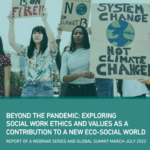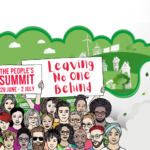Forum Replies Created
-
AuthorPosts
-
Richard
ParticipantI just received this link from colleagues in New Zealand who have been working with whole system ideas and projects. It might be something of interest in addition to the SSM link that Jane shared earlier today. For more on the work of the colleagues involved go to their About menu,
Richard
Participantthank you, Rene. Your cautionary concern is a serious issue. Aspiration to Action is not an overnight happening. I just heard an award-winning American author saying that this July 4th will mark America being free from slavery for as many years as it was a slavery policy nation – 246 years! It is why Thomas Kuhn titled his book, Scientific Revolution, instead of Scientific Evolution. Prevailing or dominant paradigm defenders will not quietly yield to a new paradigm. They will fight openly and subtlely. Resistance to changing language to match discovered facts will be employed. One only has to look at the 500 yr plus evidence/fact that the sun does not rotate around the Earth but the rotating sun language has never changed. We still admire beautiful sunrises and sunsets. And, sadly both the controllers (dominant world scientists, university academics) and the controlled (people) are loudly silent and let it be. The same is true about the factual knowledge of our spherical Earth. The “up and down” language of flat Earth continues to persist without challenge or change. “Out and In” from the Earth’s surface is foreign to most. Pilots, and when we are passengers, and air traffic controlers have corrected the language. We fly in and out of airports. However, even astronauts and ground crews, who should really know, have often been heard in communications to ask up and down questions. “What’s it like up there,” ask the ground crew. We are flying over Houston says an astronaut, “What’s the weather like down there.” I am afraid the same is true in our working together aspirations and actions. The key language is “solidarity” as if there is a solid, all-together building block of Universe. We are left without a replacement for a tightly woven pattern/braiding of togetherness or working together, which everyone talks about but won’t give up calling it solidarity. When transformational advocates keep buying into using the language of the paradigm they are trying to change, it makes it easy for the defenders to let us stay tied to the dominant way. This is how I referred to Kuhn in an Indian Journal of Social Work Journal article on social work finding a paradigm home that accurately reflects the profession, “….When the limits of a dominant paradigm are reached, Kuhn claimed that a replacement paradigm would occur through a “revolutionary” process. Revolutionary, in this context, means that transformation to a new paradigm will involve resistance. Thus, when a dominant paradigm reaches its limits there is no guarantee of a smooth and orderly transition to a new one.” We, the global we, are onto the impending crises and the importance of thinking and doing things differently but it won’t be a cakewalk as has been attested to by many of the contributors presenting at the Summit
There is hope I believe on its way from young scientists willing to question, study and bring into public discourse more of the dark side of pre-20th century Western science and help with shrinking the canopy of dominance over and subjugation of other bodies of knowledge and ways of living well in a world that leaves no one behind. One such person is Jimena Canales at the Univ Illinois, Urbana-Champaign. She was a recent dialogue guest of the Pari Center in Italy talking about the future scientist. She was quite critical of the power of measurement that has been key to the continued dominance of reductionism and the linear tenents of proportional cause and effect. The impact of Context has been driven to the sidelines. If I heard her correctly, she was affirming what David Jones posted above about biomedicine’s hardcore defense of empirical evidence when its importance, and it is important, is only about 15% of other contextual factors that play into the robust health and well-being of an individual, community or society.
Richard
ParticipantHere’s an excerpt from a recently submitted manuscript that refers to Nicholas’s article.
….Building on the shoulders of giants, a well-known quote attributed to Newton, means that the part originally started from still exists, but now it is smaller, forming a smaller part of a broad view canopy. Some have called that broad view canopy a catching up of Western science with Indigenous knowledge that has been known for a long time (Nicholas, 2018). It opens the opportunity for a co-evolution of Western science and longstanding Indigenous knowledge systems, recognizing both as necessary for building a better future (Mazzocchi, 2020)…..
Mazzocchi, F. (May 2020). A deeper meaning of sustainability: Insights from indigenous knowledge. The Antropocene Review, 7(1):77-93.Nicholas, G. (2018, February 14). It’s taken thousands of years, but Western science is finally catching up to traditional knowledge. The Conversation Canada. Retrieved April 15, 2022
Richard
ParticipantThanks David, that’s the article Here’s another one of interest to this chat and other summit participants
Richard
Participantthank you, Jane. I am not familiar with SSM but now I want to. I did a brief look at the link. Reference to soft caught my eye immediately. My work at UCalgary and community service work in suicide prevention led to the university (finally) agreeing to invest in our “soft science” work in suicide prevention (non we call it suicide-safer living). The university helped us develop LivingWorkv Education, the first (or close to the first) social enterprise company in suicide intervention training. We chose to go this social purpose route because of the uncertainty of longterm commitment of gov’t support and taxpayer criticisms when they think their $$ are going to other people or regions. It was an experiment to see if we (when I say We, I refer to 4 start-up partners from social work, psychiatry, psychology) to see if we could successfully use a business model to sustain a social purpose mission initiative. Our bottom line was aimed at large-scale dissemination of suicide safer training. so far it has worked out fairly well. LivingWorks will celebrate its 40th anniversary in 2023. We have national offices in 3 countries (Canada, America, Australia) and a network of over 10,000 locally/community-based trainers in more than 30 countries. We have indigenized cultural context and language versions serving Inuit, Maori, Aborigine, Norwegian, Lithuanian, south Korean populations. The most recent is I-ASIST in Australia between Univ QLD, LW and participatory action input. One of the unexpected spin-offs of our early work (80s and 90s) was an invitation by the UN social policy division to organize, host, fundraise an interregional meeting of representatives from 12 countries (Canada, America, Australia, Finland, Netherlands, Nigeria, UAE, Japan, China, India, Estonia, Hungary) to draft a UN Guideline for the development and implementation of national suicide prevention strategies that was published in 1996 and guided several countries in the development of their suicide prevention strategies. The original UN request was based on the false notion that suicide was a mental health problem and looked after by WHO. They realized from a document we submitted in response to a meeting by Ministers of social Welfare on the future of developmental social welfare that suicide was an intersectoral problem, not only a mental health problem. We were asked to help correct the misconception. Our meeting in Calgary in 1993 was a bit like this important 4-day summit and its Charter process to have a working draft at the end. We had a 7-day meeting in Canada to draft and submit to the UN, Out of the rich diversity of the participants and diverse attitudes and beliefs about suicide, we meant the deadline.
I was intrigued with the SSM process and its close fit with David Bohm’s belief and practice in deep dialogue that allowed for solutions to arise out of the dialogue. I have been a follower of his work for many years and continue through an association with the Pari Center in Italy that is keeping the importance of his work alive and ongoing. Leroy Little Bear from the Blackfoot Nation in southern Alberta is an active participant with the Pari Centre and the work of understanding and respecting the convergence of 20th-century science (especially quantum developments) and indigenous science/knowledge. A recent article on this emerging convergence had a headline along the line of “Western science is finally starting to catch up with indigenous science and knowledge”.
Richard
Participantthank you to Rene and all the panel members for a diverse and inspiring panel dialogue. I really like the way it was planned and organized to bridge between all the experiences. A little of my context. Although I am clearly the product of a rural, western Canadian, living most of my adult life in urban Calgary, I have had the good fortune to have some other cultural and lived experiences. Some of this was as a member of IFsW executive for many years, most of them as treasurer. I had the honor of holding the Tata Institue Chair in social work in the mid-90s and helped one of our students experience an international practicum experience working with low-income farmers in Kerala. I had the opportunity write about history and paradigm shifts over several centuries in the Indian Journal of sW (199). I was worried then that the prof was largely trapped or frozen in the pre-20th century version of science (the biomedical model you addressed) and risked being several paradigm shifts behind by the dawn of the 21st century. Here we are 1/4 into the 21st calling for game-changing paradigm shifts in all sectors. I was struck by several key words woven into many of your individual and collective remarks: conception, holistic, biomedical, solidarity, plural pathways, space for debate. Finding a common conceptual framework/model for social work is a longtime interest. Holistic too has been a long time interest. I was introduced to systems thinking in grad studies in the 60s. Holistic became clearer when I connected with Buckminster Fuller’s work on Whole systems and Nature’s basic coordiante system, the tetrahedron, which is also the molecular structure of the carbon atom – the essence of life. Holism for me is now spelled with a “w”. sadly I think holism is still mostly rhetoric for many. The togetherness meaning of solidarity has intrigued me for quite awhile. When you connect it to reductionist science’s quest for a basic building block and the 20th century quantum science and the reemergence of indigenous sciences/knowledge that there is no building block to be found; it is all about relations, the meaning is right but the word is wrong. solid is fixed, rigid, compact, etc. Plurality has a hard time emerging with this concept. It in my opinion the word keeps us somewhat trapped in the very paradigm we are trying to transform. Plural pathways connect me to Fuller’s definition of unity. Unity is not oneness; it is plural, minimum two. Creating space, safe space is so important as the panel made clear throughout. Debate is important. I like what I have learned from David Bohm’s work on Undivided and Divided Wholeness worldviews and the importance of genuine space for dialogue, reflection, listening, and most important hearing and respecting others with genuiness. I would love to dialogue further and explore some of the conceptioning work I have tried might be able to map the messages and inspiration of the plural pathways panel into a conceptual model that can “house” and advance what you have presented on co-building a better world for everyone.
Richard
Participanthttps://www.ucalgary.ca/sw/ramsay/papers2/Armstrong-94-professional-model-social-work-practice-1.html
I couldn’t find the model I wanted to paste. Here’s a link to a student paper in my early work. A quick scroll will find graphics of the 4 components and how they are integrated. The text is interesting. She describes a medical case conference trying to find a way to work with a non compliant, recent immigrant patient, recently diagnosed with MS. The student was an observer, not part of the team. As they talked (and fussed), she mapped what she heard and observed on a map of the model. She was confident enough to ask if she could comment. The non-compliance looked like a clash of cultural values/validators. The patient believed MS was acute/curable. The medical team held it to be chronic/life long. The non compliance medical patient relationship was connected to medical and patient validators in conflict. The doctor lead saw the relationship source right away. The team agreed to put their validator aside and work with the patient’s cultural validator. The compliance conflict turned into a compliant patient quite quickly and the social work student became a regular at the case conference table for her social work perspectiveRichard
ParticipantHere’s some text content from my faculty days at Univ of Calgary
Brief Overview of Common Whole of Social Work
2003 Social Work Course HandoutA longstanding interest in the nature of social work led to my search for an organizing structure to identify a common conceptual framework. I was introduced to the work of Buckminster Fuller and his discovery of nature’s minimum whole system, the geometric tetrahedron (Fuller, 1992; Fuller and Dil, 1983; Fuller, 1975; Fuller, 1969).
Fuller discovered the simplest whole system experience of Universe to be geometrically tetrahedral; a unique set of interdependent connections consisting of four (4) parts, four (4) faces, and six (6) connections. It is nature’s minimum “set of elements standing in interaction” that constitutes a whole experience. Anything less than tetrahedral is not whole. A tetrahedral system provides a geometric way of thinking in which basic properties of the system are invariant (do not change) when undergoing transformations.
Understanding the tetrahedral system recognizes the need for a minimum of four “somethings” (e.g. components, elements, things, persons) all interconnected to form a wholistic conceptual framework. Each component can be unfolded or multiplied into its own minimum system (or more) complexity and then reconfigured to show the progressive complexity between the components.
A common conceptual framework would need a minimum of four interconnected components. Each component would not be unique by itself, but together they would constitute a common whole of social work. Each component would have relevant knowledge bases from the humanities and sciences that inform how they are expressed and apply in different cultures and societies.
Working with a four-dimensional framework, four conceptual components were thought to be universal to the profession. Their selection came from three sources: Bartlett’s Common Base of Social Work Practice (1970); Wilber’s Eye to Eye: The Quest for the New Paradigm (1990); and Kuhn’s The Structure of Scientific Revolutions (1970).
Bartlett’s common base had three core components: a central focus on social functioning, a broad orientation to people being served (directly or indirectly), and an interventive repertoire of helping methods. The importance of professional use of self was described but not given the status of a core component in her framework.
Wilber explored three realms of knowledge – empirical realm of the senses, rational realm of the mind, and contemplative realm of the spirit. He argued that any kind of discipline or profession could be considered a science provided it had a distinguishable domain (the central focus described by Bartlett) and a methodology (Bartlett’s interventive repertoire) that was open to knowledge generation and applications being challenged and refuted.
Kuhn introduced the concept of paradigm as a way of identifying communities of like-minded groups engaged in any form of disciplinary or professional endeavor. The paradigm component of a common framework would identify a community of like-minded people who adhere around common questions, problem interests, values, ethics, sanctions, practice approaches, methods of inquiry and validation, curriculum contents, and who have a declared orientation toward people.
Common Components of Social Work
Domain of Social Work Practice
This component includes Bartlett’s social functioning focus, generally recognized as social work’s person-in-environments area of practice. Based on historical and practice evidence, she identified three critical elements in the social work domain: Person-Interaction-Environment (PIE) which describes person-in-environment interactions. The distinguishing feature of this domain is the central focus on the interactional networks and patterns between person(s) and environment(s). This feature identifies social work as a relationship-centered profession. The PIE domain unfolds into minimum four-fold complexity. The core elements are: Person, Personal Otherness, Resource otherness, and Validator otherness (Ramsay, 1994). Social well-being is the primary concern of the social work profession. Central to this concern is a vision of just and civil societies throughout the world (Witkin, 1999).The ‘person’ element in varying size configurations refers to the developmental, demographic, and social functioning status of individuals in family, groups, and communities. Environment includes the other three elements. How they operate in a society enhances or impedes the development of individual and collective social well-being and reciprocally how people “treat” their environments affects their well-being.
The ‘personal other’ element includes natural support networks; the others in one’s life who are or are deemed to be intimate, close, supportive, and personally connected.
The ‘resource others’ element includes the major institutional structures of a society (e.g. health, welfare, education, transportation, employment, and so on) that enhance and/or impede social well-being.
The ‘validator otherness’ element includes the complexity of societal norms and expectations in the form of influential attitudes, beliefs, customs, policies, and laws that shape and “govern” the nature and interrelationships between all the elements.
Social functioning addresses the relationship between the coping capacity of individuals, families and communities and the demands of their environments. Environments included the social and physical contexts or surroundings in which human behavior occurs. The social functioning of people in their contextual environments offers a strong indication of their social well-being and the level to which the structural institutions that affect them provide a just and civil society to live in.
Paradigm of the Profession
This component identifies social work as a community of like-minded people who have a shared understanding of the profession and how it is practiced. The concept of a like-minded community stretches beyond national borders. The IFSW has fostered the development of a common adherence to ethics and values since its beginning in 1928. Recent contributions include the international declaration of ethical principles (IFSW, 1994), the updated international definition of social work (IFSW, 2000), and the Global Standards for Social Work Education (IFSW-IASSW, 2004). National organizations of social workers provide their members with contextually developed codes of ethics, complementing legislative statutes in many jurisdictions that require common standards of practice and regulatory systems in the interests of public protection. Social work is a higher education endeavor and common curriculum requirements set by sanctioned accrediting bodies are the norms in most countries that offer social work education. The common sanctions (e.g. society, law, agency/program, and profession) that authorize and give social work permission to be fully or restrictively practiced are contextually connected to the paradigm component and influence the extent to which social workers can practice their profession.The paradigm component includes generalists and specialists. It “houses” the knowledge part of social work, drawn from indigenous knowledge-traditions, humanities, and sciences (not just the Western sciences) to advance the development of common human rights, distributive justice, and sufficient societal structures for individual, family, and community social well-being in all human societies. Social workers are expected to respect the value of cultural and ethnic diversity and strive to alleviate discrimination, oppression, poverty and other forms of social injustice, even when it is in the guise of cultural and ethnic diversity.
Social workers have practice options enabling them to work directly with client groups, indirectly through other environmental elements, or both. Three interconnected practice options are common in social work:
• Direct work with clients through a relationship;
• Target an environment element to influence it in a way that will benefit a client (case advocacy) or other people served (cause advocacy); and
• Work through established action system networks (internal or external) to provide direct services or provide support for direct and indirect practice options.Domain of Social Worker/Practitioner
This component identifies the significance of a social worker’s own PIE and its impact on their practice of social work. The disciplined use of self requires a comprehensive understanding of the elements and relationships in his/her PIE network. Social workers must constantly monitor themselves in relation to their natural support networks, societal structures, and the variety of validator norms and expectations in the form of influential attitudes, beliefs, customs, policies, and laws that shape their personal and professional lives. The PIE domain that is brought to the workplace on a daily basis interconnects with the Paradigm of the Profession component to activate the integrated dynamics of one’s personal-professional approach to practice. Social workers are expected to understand the co-existence of the personal and professional and to consciously use this complementary dynamic in their practice activities.Methods of Practice
This component identifies the professional interventions and particular modalities of practice that are informed by multiple theoretical perspectives and “evidence-based” in today’s parlance and open to refutation. It is generally defined as “an orderly systematic mode of procedure” (Brieland, 1977, p. 345). The other components are systemic in nature (similar to interconnected networks). Systematic methods are usually described in the form of phases (e.g. study, diagnosis, and treatment, Richmond, 1917; observation, assessment, plan of action, NASW, 1958; dialogue, discovery, development, Miley, O’Melia, DuBois, 2001). Tetrahedral principles recognize that the systematic process can have multiple phases but always a minimum of three or four phases. The intervention nature of this component is defined as the “action of the practitioner which is directed to some part of a social system or process with the intention of inducing a change in it” (p. 76). Social work interventions include direct practice with clients, community organizing, advocacy, social and political action, policy development and implementation, education, and research and evaluation.Common Conceptual Framework
Together the four components (three systemic and one systematic) are configured into a Common Whole of Social Work model. The graphic depiction of the constellation allows one to see the individualized pathway of clients and/or other expected beneficiaries in their person-in-environment context becoming connected with the personal-professional networks of a social worker on his/her pathway. In situations where the social worker participates directly with client systems, they will work together in a collaborative relationship through a co-empowering intervention method selected from social work’s repertoire of interventions. In situations where the social worker is working indirectly through others to benefit a client (case advocacy) or people, in particular, situations (cause advocacy), the method selected and skills applied will be directed to expectations of collaborative and co-empowered outcomes that will not advantage or disadvantage one group over another.References
Bartlett, H (1970). Common Base of Social Work Practice (1970). New York: NASW.Brieland D. (1981). Definition, specialization, and domain in social work. Social Work 26(1), 79-82.
Fuller RB. Kuromiya K (adjuvant). (1992). Cosmography: A Posthumous Scenario for the Future of Humanity. New York: Macmillan Publishing Company.
Fuller RB, Dil A (1983). Humans in Universe. New York: St. Martins Press.
Fuller RB. in collaboration with EJ Applewhite (1975). Synergetics: Explorations in the Geometry of Thinking. New York: Collier Books, Mac Millan Publishing Company.
Fuller RB (1969). Utopia or Oblivion: The Prospects for Humanity. Woodstock, NY: The Overlook Press..
IFSW (2000). International Federation of Social Workers Definition of Social Work. Berne: International Federation of Social Workers.
IFSW (1994). International Declaration of Ethical Principles for Social Work. Oslo: International Federation of Social Workers
IFSW-IAASW (2004). Global Standards for the Education and Training of the Social Work Profession. Adelaide: Final Document adopted at the General Assemblies of the International Federation of Social Workers and International Association of Schools of Social Work.
Kuhn T (1970). The Structure of Scientific Revolutions (2nd ed., enlarged), Chicago: University of Chicago Press.
Miley KK, O’Melia M, DuBois BL (2001). Generalist Social Work Practice: An Empowering Approach (3rd Edition). Boston: Allyn and Bacon.
Ramsay RF (1994). Conceptualizing PIE within a holistic conception of social work. In J Karls and K Wandrei (eds.), Person-in-Environment System: The PIE Classification System for Social Functioning Problems (171-195). Washington, DC: NASW Press.
Wilber K (Expanded edition) (1990). Eye to Eye:The Quest for the New Paradigm. Boston: Shambhala Publications.
Witkin S (July, 1999). Editorial: Identities and contexts. Social Work Vol. 44(4), 293-297.
Richard Ramsay, Professor Emeritus of Social Work, University of Calgary
ramsay1@telusplanet.netRichard
ParticipantI tried a cut and paste that doesn’t seem to work
Go to the Ubuntu workshop part of the program. It is UC006. I wasn’t happy with my recording. Too slow and sometimes plodding. The positive side of recording is the ability to fast forward or scan the text if the audio is taking too long. The canopy slides are near the end show the dominance of the current canopy and the overshadowing/longtime suppression/dismissal of others. After the 7 transformational Ethical Principles changes we are encouraging dialogue around, we show what we believe to be a more desirable and co-equal canopy.Richard
ParticipantI’ve been tied up with some other things today (in Calgary and MTN time zone). I want to get back to sarah’s and share more about wholism and dimensions (I spell holism more and more with the “w”). I will be able to share text and maybe some graphics to show how I have put systemic (issues, concerns, barriers, etc) together with systematic (methods, processes, approaches …) to conceptualize a common whole model and way of practicing social work that is founded on the principle of co-building in all of its “co” partners – codetermination, coexistence, cohabitate, co-lead, co-empower …..
Richard
ParticipantI haven’t had a chance to attend the panel. Hopefully, a little later this afternoon and then share a comment. I am in Calgary (mtn zone). Keen on continuing the dialogue on this important theme. Our Ubuntu workhop has a graphic to illustrate the “canopy” shrinking that is needed to allow the growth and regrowth and remergence of other ways of knowing/sciences so that the power in the prefix “co” can really happen locally and globally -cobuild, codetermination, collaborate, cooperate, coexist ……
Richard
ParticipantBuckminster Fuller talked about this kind of kind of individual-collective complementarity and a clear understanding that they go together. Just like concepts of concave-convex, you can’t have one without the other. Fuller was a little wordy in thinking about self-Other. It goes like this. In order to have Self there must be Awareness. To have awareness there must be Other. In reverse thinking, No Other, No Awareness, No Self. Lynn Margulis found individualism to be a separated illusion. Individual-collective are always together, like concave-convex. You can’t separate 1 from the other which is what pre-20th century Western science tried to do with mind-body separation, observer-object separation (so-called objectivity). Giving in and following this kind observer objectivity has been disastrous in Western style social work and the spreading effect it has had on social work teaching and practice over the last 125 years
Richard
ParticipantI would like to spend more time on these 4 to surface a deeper understanding of their wholistic interconnections and how wholistic (geometric) thinking models may help us away from the linear trap of listing them as if they were separate and inviting suggestions for additional values in the spirit of non-wholistic thinking that a long list of added values guided by part-to-whole thinking will reach a wholistic values set. Whole-to-part thinking would not keep us trapped in a linear, non-wholistic trap while claiming to be wholistic. The notion of wholism will remain significant in rhetoric only. I would like dialogue on rearranging the 4 value sets from a linear list to a geometric tetrahedron-like system that shows the 4 values and their minimum of 6 interconnections in a non-linear and non-hierarchial way. This moves us into 3-D modeling that can also take 2D circle models like indigenous medicine wheel models and “see” them in their 3D wholism too (and I believe, in the way they are meant to be understood). This kind of modelling can expand and contract to undersstand and work with a minimum 4 set or a complex pattern/set of multiple interconnection values understood in the context of whole-to-part thinking instead of our current mostly part-to-whole thinking mindsets that keep us trapped in the rhetoric of wholism and not the practice of wholism. Richard Ramsay
Richard
ParticipantI would like to dialogue. Our Ubuntu workshop speaks to the need to SHRINK the dominant canopy of pre-20thC Western science (reductionist, separateness, observer objectivity, etc). Growth of 20thC science and regrowth of indigenous science/knowledge needs to expand to have a genuine co-science and practice canopy. Blackfoot Physics book by David Peat in the early 2000 speaks to this co-ness. Significant changes are needed to the IFsW Ethical Principles statement if the profession is to be serious about walking-the-talk of co-building.
Richard Ramsay, Calgary -
AuthorPosts






